Cropland Product Fusion Method Based on the Overall Consistency Difference: A Case Study of China
Abstract
1. Introduction
2. Background
2.1. Description of the Data Sources for Fusion
2.2. Generalized Model for Generating a Synergy Cropland Product
2.2.1. Creation of the Fusion Combination Level Table
2.2.2. Fusion of Cropland Products Based on the Direct Arithmetic Average Method
2.2.3. Determination of the Best Combination Level with Cropland Statistics
3. Model for Generating the Synergy Cropland Product by Fusing the Cropland Products Based on the Overall Consistency Difference
3.1. Preprocessing of Cropland Products
3.2. Creation of the Fusion Combination Level Table
3.3. Fusion of Remote Sensing Cropland Products Based on the Overall Consistency Difference
3.4. Determination of the Best Combination Level
4. Experiments and Analysis
4.1. Accuracy Measurement
4.1.1. Accuracy of Cropland Area Estimation
4.1.2. Accuracy of the Spatial Positioning
- Overall accuracy (OA): The OA represents the ratio of correct samples to the total number of test samples , indicating whether the product category is the same as the real ground-truth data [35]. The equation is as follows:
- Kappa coefficient (kappa): The kappa coefficient is a discrete calculation method that is a statistic that obtains the consistency of the probability by observing the main diagonal and the total number of rows and columns in the confusion matrix [36]:
4.2. Experimental Results
4.2.1. Accuracy of the Cropland Area Estimation
4.2.2. Accuracy of the Spatial Positioning
4.3. Results Analysis
5. Conclusions
Author Contributions
Acknowledgments
Conflicts of Interest
References
- Liu, J.; Liu, M.; Tian, H.; Zhuang, D.; Zhang, Z.; Zhang, W.; Tang, X.; Deng, X. Spatial and temporal patterns of China’s cropland during 1990–2000: An analysis based on Landsat TM data. Remote Sens. Environ. 2005, 98, 442–456. [Google Scholar] [CrossRef]
- Lamb, D.W.; Brown, R.B. Pa—Precision agriculture: Remote-sensing and mapping of weeds in crops. J. Agric. Eng. Res. 2002, 78, 117–125. [Google Scholar] [CrossRef]
- Loveland, T.R.; Reed, B.C.; Brown, J.F.; Ohlen, D.O.; Zhu, Z.; Yang, L. Development of a global land cover characteristics database and IGBP discover from 1 km AVHRR data. Int. J. Remote Sens. 2000, 21, 1303–1330. [Google Scholar] [CrossRef]
- Hansen, M.; Defries, R.; Townshend, J.R.; Sohlberg, R. UMD Global Land Cover Classification, 1 kilometer, 1.0; Department of Geography, University of Maryland: College Park, MD, USA, 1998. [Google Scholar]
- Bartholome, E.; Belward, A.S. GLC2000: A new approach to global land cover mapping from Earth observation data. Int. J. Remote Sens. 2005, 26, 1959–1977. [Google Scholar] [CrossRef]
- Friedl, M.A.; Sulla-Menashe, D.; Tan, B.; Schneider, A.; Ramankutty, N.; Sibley, A.; Huang, X. MODIS Collection 5 global land cover: Algorithm refinements and characterization of new datasets. Remote Sens. Environ. 2010, 114, 168–182. [Google Scholar] [CrossRef]
- Pittman, K.; Hansen, M.C.; Becker-Reshef, I.; Potapov, P.V.; Justice, C.O. Estimating global cropland extent with multi-year MODIS data. Remote Sens. 2010, 2, 1844–1863. [Google Scholar] [CrossRef]
- Bontemps, S.; Defourny, P.; Bogaert, E.V.; Arino, O.; Kalogirou, V.; Perez, J.R. “GLOBCOVER 2009-Products description and validation report. Foro Mundial De La Salud 2010, 17, 285–287. [Google Scholar]
- Chen, J.; Chen, J.; Liao, A.; Cao, X.; Chen, L.; Chen, X.; Peng, S.; Han, G.; Zhang, H.; He, C.; et al. Concepts and Key Techniques for 30m Global Land Cover Mapping. Acta Geodaetica Cartogr. Sin. 2014, 43, 551–557. [Google Scholar]
- Brovelli, M.A.; Molinari, M.E.; Hussein, E.; Chen, J.; Li, R. The first comprehensive accuracy assessment of GlobeLand30 at a national level: Methodology and results. Remote Sens. 2015, 7, 4191–4212. [Google Scholar] [CrossRef]
- Yu, L.; Wang, J.; Gong, P. Improving 30 meter global land cover map FROM-GLC with time series MODIS and auxiliary datasets: A segmentation based approach. Int. J. Remote Sens. 2013, 34, 5851–5867. [Google Scholar] [CrossRef]
- Chen, D.; Wu, W.; Lu, M.; Hu, Q.; Zhou, Q. Progresses in Land Cover Data Reconstruction Method Based on Multi-Source Data Fusion. Chin. J. Agric. Resour. Reg. Plan. 2016, 37, 62–70. [Google Scholar]
- Lu, M.; Wu, W.; Zhang, L.; Liao, A.; Peng, S.; Tang, H. A comparative analysis of five global cropland datasets in china. Sci. China Earth Sci. 2016, 59, 2307–2317. [Google Scholar] [CrossRef]
- Dendoncker, N.; Rounsevell, M.; Bogaert, P. Spatial analysis and modelling of land use distributions in Belgium. Computers. Environ. Urban Syst. 2007, 31, 188–205. [Google Scholar] [CrossRef]
- Song, X.P.; Huang, C.; Feng, M.; Sexton, J.O.; Channan, S.; Townshend, J.R. Integrating global land cover products for improved forest cover characterization: An application in North America. Int. J. Digit. Earth 2014, 7, 709–724. [Google Scholar] [CrossRef]
- See, L.; Schepaschenko, D.; Lesiv, M.; McCallum, I.; Fritz, S.; Comber, A.; Perger, C.; Schill, C.; Zhao, Y.; Maus, V.; et al. Building a hybrid land cover map with crowdsourcing and geographically weighted regression. ISPRS J. Photogramm. Remote Sens. 2015, 103, 48–56. [Google Scholar] [CrossRef]
- Schepaschenko, D.; See, L.; Lesiv, M.; McCallum, I.; Fritz, S.; Salk, C.; Moltchanova, E.; Perger, C.; Shchepashchenko, M.; Shvidenko, A.; et al. Development of a global hybrid forest mask through the synergy of remote sensing, crowdsourcing and FAO statistics. Remote Sens. Environ. 2015, 162, 208–220. [Google Scholar] [CrossRef]
- Ran, Y.; Li, X.; Lu, L. China Land Cover Classification at 1 km Spatial Resolution Based on a Multi-source Data Fusion Approach. Adv. Earth Sci. 2009, 24, 192–203. [Google Scholar]
- Chen, D.; Lu, M.; Zhou, Q.; Xiao, J.; Ru, Y.; Wei, Y.; Wu, W. Comparison of Two Synergy Approaches for Hybrid Cropland Mapping. Remote Sens. 2019, 11, 213. [Google Scholar] [CrossRef]
- Pérez-Hoyos, A.; García-Haro, F.J.; San-Miguel-Ayanz, J. A methodology to generate a synergetic land-cover map by fusion of different land-cover products. Int. J. Appl. Earth Obs. Geoinf. 2012, 19, 72–87. [Google Scholar] [CrossRef]
- Gengler, S.; Bogaert, P. Combining land cover products using a minimum divergence and a Bayesian data fusion approach. Int. J. Geogr. Inf. Sci. 2018, 32, 806–826. [Google Scholar] [CrossRef]
- Xu, G.; Zhang, H.; Chen, B.; Zhang, H.; Yan, J.; Chen, J.; Che, M.; Lin, X.; Dou, X. A Bayesian based method to generate a synergetic land-cover map from existing land-cover products. Remote Sens. 2014, 6, 5589–5613. [Google Scholar] [CrossRef]
- Waldner, F.; Fritz, S.; di Gregorio, A.; Defourny, P. Mapping priorities to focus cropland mapping activities: Fitness assessment of existing global, regional and national cropland maps. Remote Sens. 2015, 7, 7959–7986. [Google Scholar] [CrossRef]
- Jung, M.; Henkel, K.; Herold, M.; Churkina, G. Exploiting synergies of global land cover products for carbon cycle modeling. Remote Sens. Environ. 2006, 101, 534–553. [Google Scholar] [CrossRef]
- Ramankutty, N.; Evan, A.T.; Monfreda, C.; Foley, J.A. Farming the planet: 1. Geographic distribution of global agricultural lands in the year 2000. Glob. Biogeochem. Cycles 2008, 22, 1–19. [Google Scholar] [CrossRef]
- Zhang, N.; Tateishi, R. Integrated use of existing global land cover datasets for producing a new global land cover dataset with a higher accuracy: A case study in Eurasia. Adv. Remote Sens. 2013, 2, 365–372. [Google Scholar] [CrossRef][Green Version]
- Schepaschenko, D.; McCallum, I.; Shvidenko, A.; Fritz, S.; Kraxner, F.; Obersteiner, M. A new hybrid land cover dataset for Russia: A methodology for integrating statistics, remote sensing and in situ information. J. Land Use Sci. 2011, 6, 245–259. [Google Scholar] [CrossRef]
- Fritz, S.; You, L.; Bun, A.; See, L.; McCallum, I.; Schill, C.; Perger, C.; Liu, J.; Hansen, M.; Obersteiner, M. Cropland for sub-Saharan Africa: A synergistic approach using five land cover data sets. Geophys. Res. Lett. 2011, 38, 155–170. [Google Scholar] [CrossRef]
- Lu, M.; Wu, W.; You, L.; Chen, D.; Zhang, L.; Yang, P.; Tang, H. A Synergy Cropland of China by Fusing Multiple Existing Maps and Statistics. Sensors 2017, 17, 1613. [Google Scholar] [CrossRef] [PubMed]
- Rui, Y.; Huang, T.S.; Ortega, M.; Mehrotra, S. Relevance feedback: A power tool for interactive content-based image retrieval. IEEE Trans. Circuits Syst. Video Technol. 1998, 8, 644–655. [Google Scholar]
- Doulamis, N.; Doulamis, A. Evaluation of relevance feedback schemes in content-based in retrieval systems. Signal Process. Image Commun. 2006, 21, 334–357. [Google Scholar] [CrossRef]
- Liu, Z.; Cheng, Y.; Pan, Q.; Miao, Z. Weight Evidence Combination for Multi-Sensor Conflict Information. Chin. J. Sens. Actuators 2009, 22, 15. [Google Scholar]
- Cao, Z. Eigenvalue Problem of Matrix; Science and Technology Publishing House: Beijing, China, 1980. [Google Scholar]
- Bo, Y.; Wang, J. Study on Uncertainty of Remote Sensing Information: Classification and Scale Effect Model; Geological Publishing House: Beijing, China, 2003. [Google Scholar]
- Congalton, R.G. A review of assessing the accuracy of classifications of remotely sensed data. Remote Sens. Environ. 1991, 37, 35–46. [Google Scholar] [CrossRef]
- Viera, A.J.; Garrett, J.M. Understanding interobserver agreement: The kappa statistic. Fam. Med. 2005, 37, 360–363. [Google Scholar]
- Gong, P.; Wang, J.; Yu, L.; Zhao, Y.; Zhao, Y.; Liang, L.; Niu, Z.; Huang, X.; Fu, H.; Liu, S.; et al. Finer resolution observation and monitoring of global land cover: First mapping results with Landsat TM and ETM+ data. Int. J. Remote Sens. 2013, 34, 2607–2654. [Google Scholar] [CrossRef]
- Fritz, S.; McCallum, I.; Schill, C.; Perger, C.; See, L.; Schepaschenko, D.; Velde, M.; Kraxner, F.; Obersteiner, M. Geo-Wiki: An online platform for improving global land cover. Environ. Model. Softw. 2012, 31, 110–123. [Google Scholar]
- Bayas, J.C.L.; See, L.; Perger, C.; Justice, C.; Nakalembe, C.; Dempewolf, J.; Fritz, S. Validation of Automatically Generated Global and Regional Cropland Data Sets: The Case of Tanzania. Remote Sens. 2017, 9, 815. [Google Scholar] [CrossRef]
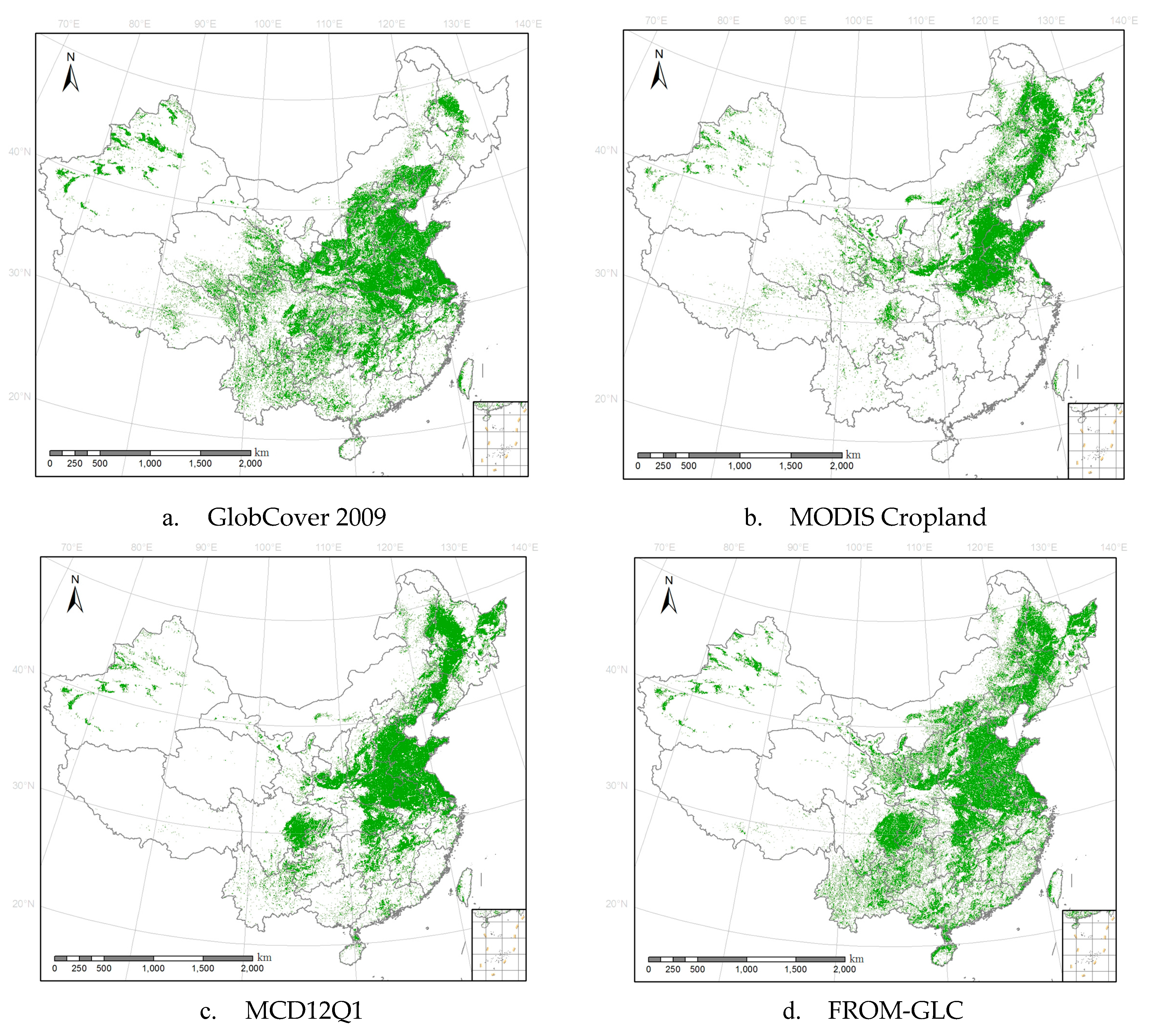

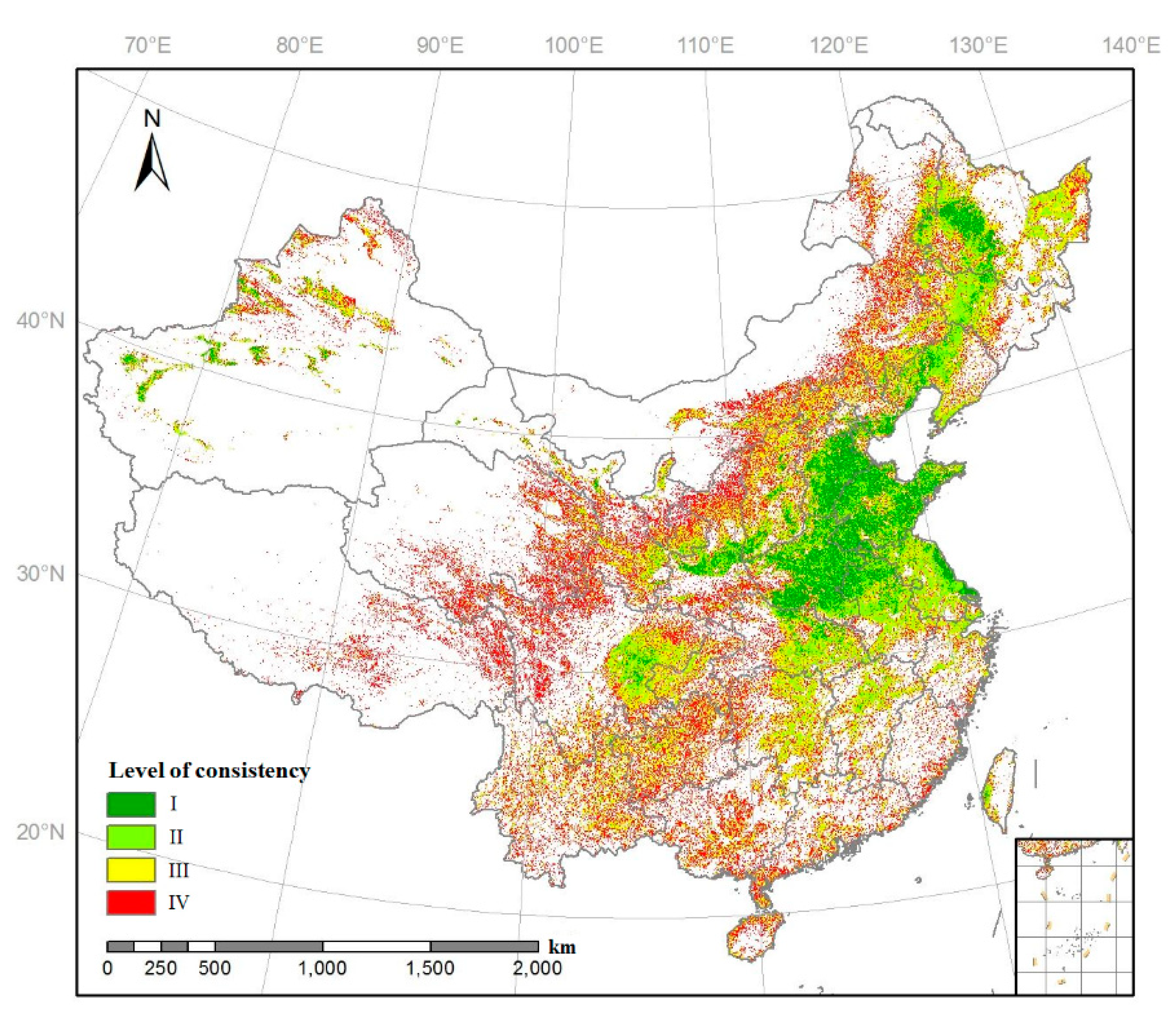
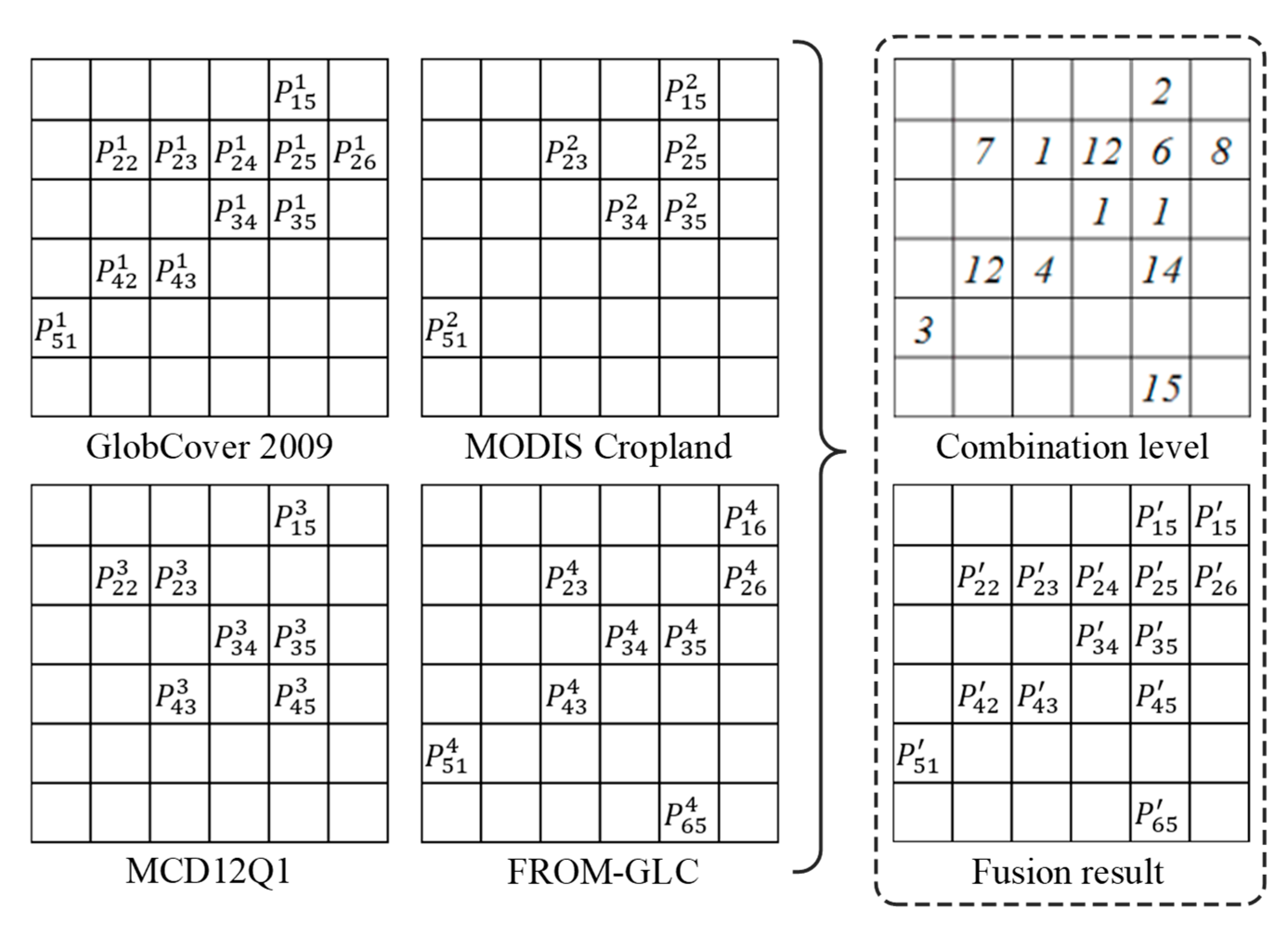


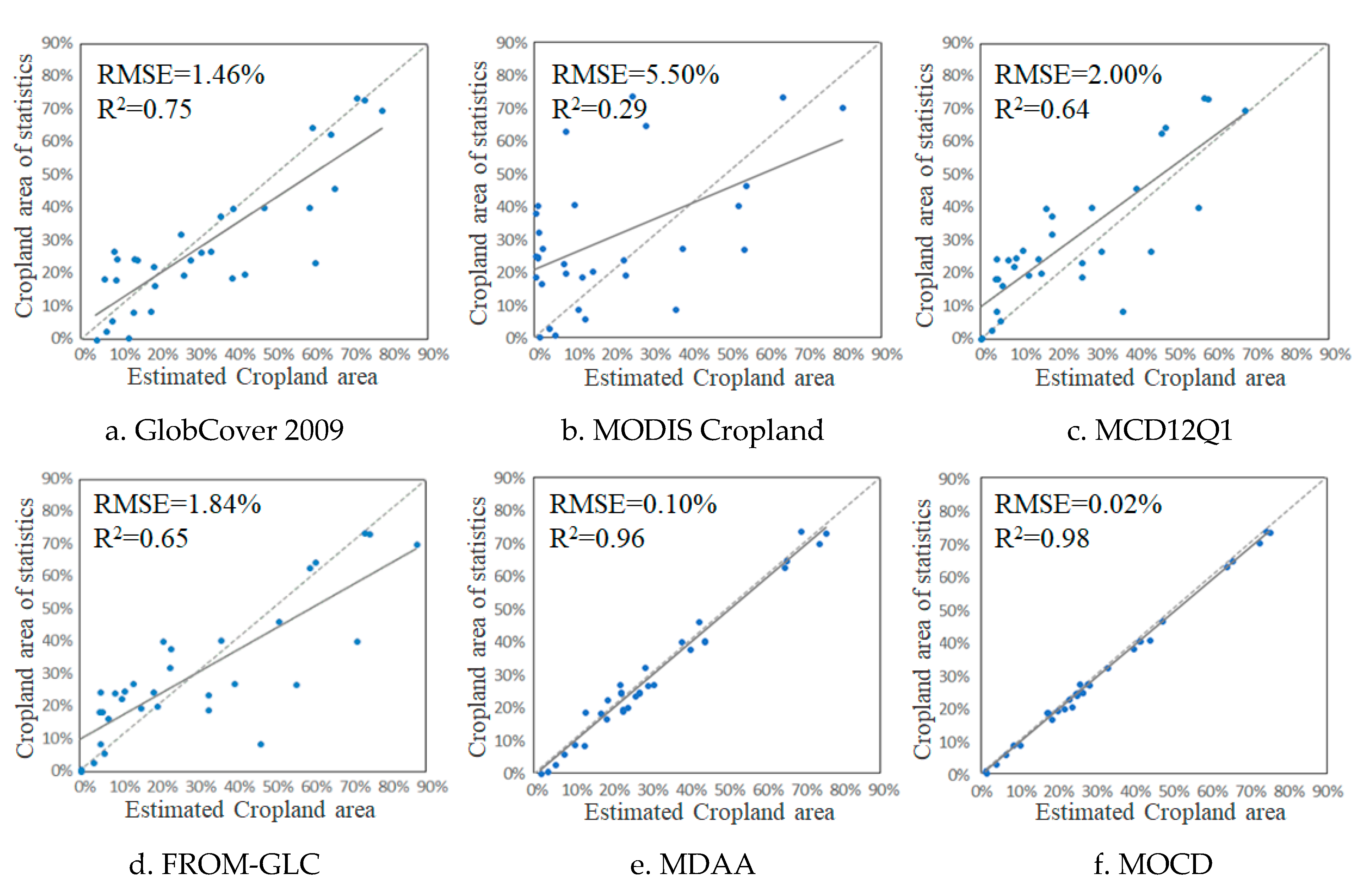
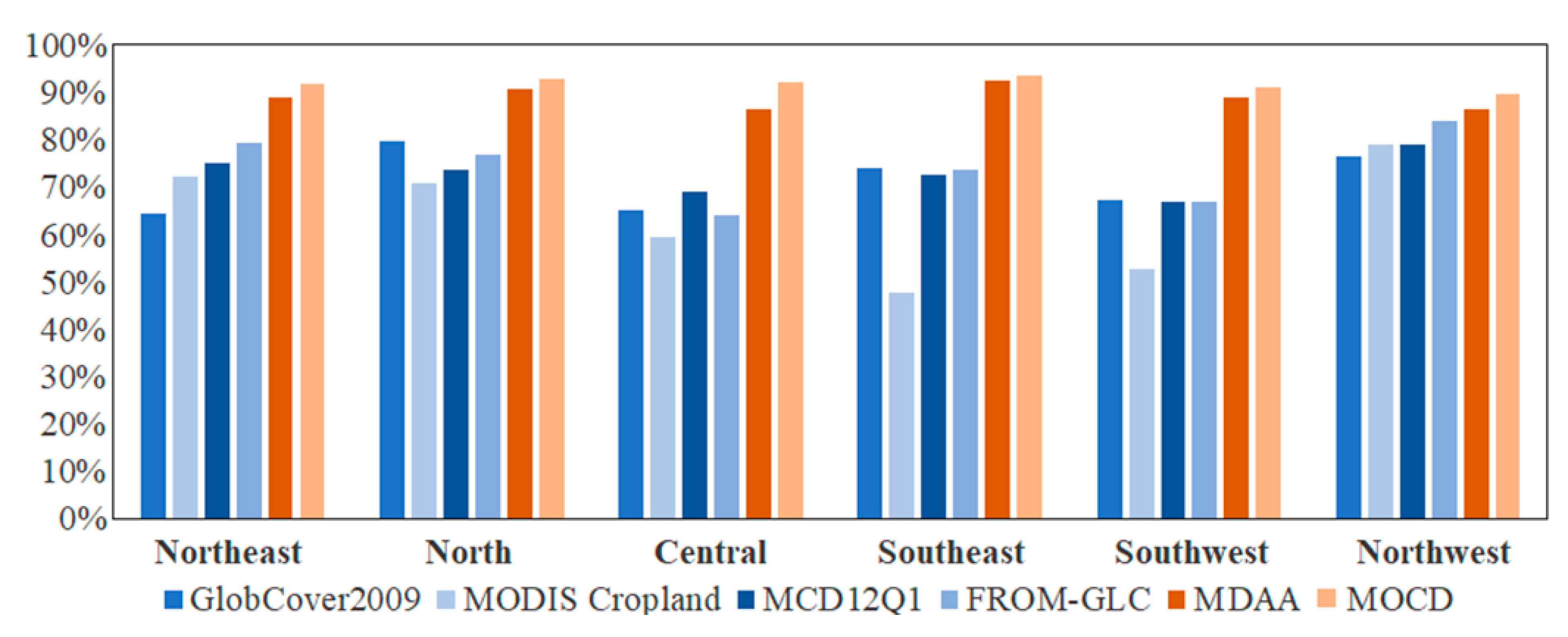
| Product | GlobCover 2009 | MODIS Cropland | MCD12Q1 | FROM-GLC |
|---|---|---|---|---|
| Time | 2009 | 2010 | 2010 | 2010 |
| Reference | ESA & UCL | USDA | Boston University | Tsinghua University |
| Satellite | MERIS | MODIS | MODIS | Landsat |
| Spatial resolution | 300 m | 250 m | 500 m | 30 m |
| Consistency Level | Combination Level | GlobCover 2009 | MODIS Cropland | MOD12Q1 | FROM-GLC |
|---|---|---|---|---|---|
| I | 1 | 1 | 1 | 1 | 1 |
| II | 2 | 1 | 1 | 1 | 0 |
| 3 | 1 | 1 | 0 | 1 | |
| 4 | 1 | 0 | 1 | 1 | |
| 5 | 0 | 1 | 1 | 1 | |
| III | 6 | 1 | 1 | 0 | 0 |
| 7 | 1 | 0 | 1 | 0 | |
| 8 | 1 | 0 | 0 | 1 | |
| 9 | 0 | 1 | 1 | 0 | |
| 10 | 0 | 1 | 0 | 1 | |
| 11 | 0 | 0 | 1 | 1 | |
| IV | 12 | 1 | 0 | 0 | 0 |
| 13 | 0 | 1 | 0 | 0 | |
| 14 | 0 | 0 | 1 | 0 | |
| 15 | 0 | 0 | 0 | 1 |
| GlobCover 2009 | MODIS Cropland | MCD12Q1 | FROM-GLC | MDAA | MOCD | |
|---|---|---|---|---|---|---|
| OA | 76.23% | 67.99% | 73.49% | 79.61% | 89.09% | 91.99% |
| Kappa | 0.52 | 0.38 | 0.47 | 0.58 | 0.77 | 0.83 |
| MR | 21.66% | 13.68% | 20.79% | 19.70% | 11.09% | 8.97% |
| LR | 21.11% | 49.86% | 29.31% | 21.33% | 6.49% | 3.86% |
© 2019 by the authors. Licensee MDPI, Basel, Switzerland. This article is an open access article distributed under the terms and conditions of the Creative Commons Attribution (CC BY) license (http://creativecommons.org/licenses/by/4.0/).
Share and Cite
Zhong, Y.; Luo, C.; Hu, X.; Wei, L.; Wang, X.; Jin, S. Cropland Product Fusion Method Based on the Overall Consistency Difference: A Case Study of China. Remote Sens. 2019, 11, 1065. https://doi.org/10.3390/rs11091065
Zhong Y, Luo C, Hu X, Wei L, Wang X, Jin S. Cropland Product Fusion Method Based on the Overall Consistency Difference: A Case Study of China. Remote Sensing. 2019; 11(9):1065. https://doi.org/10.3390/rs11091065
Chicago/Turabian StyleZhong, Yanfei, Chang Luo, Xin Hu, Lifei Wei, Xinyu Wang, and Shuying Jin. 2019. "Cropland Product Fusion Method Based on the Overall Consistency Difference: A Case Study of China" Remote Sensing 11, no. 9: 1065. https://doi.org/10.3390/rs11091065
APA StyleZhong, Y., Luo, C., Hu, X., Wei, L., Wang, X., & Jin, S. (2019). Cropland Product Fusion Method Based on the Overall Consistency Difference: A Case Study of China. Remote Sensing, 11(9), 1065. https://doi.org/10.3390/rs11091065






